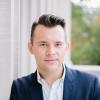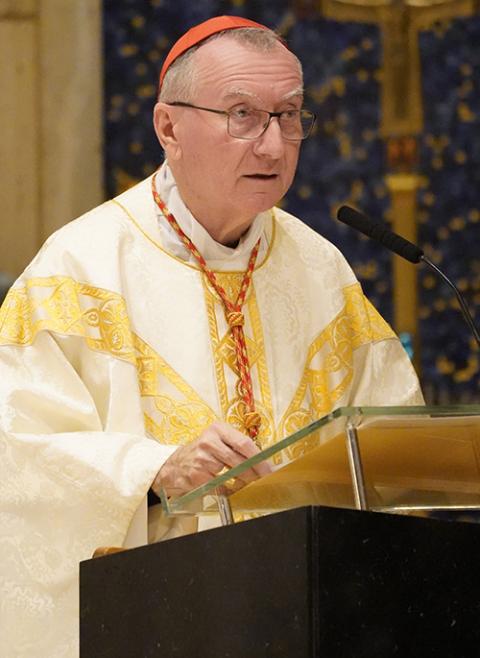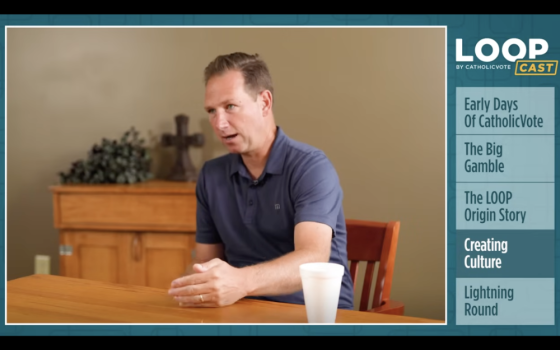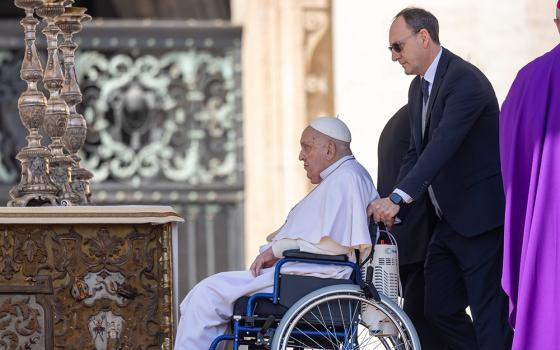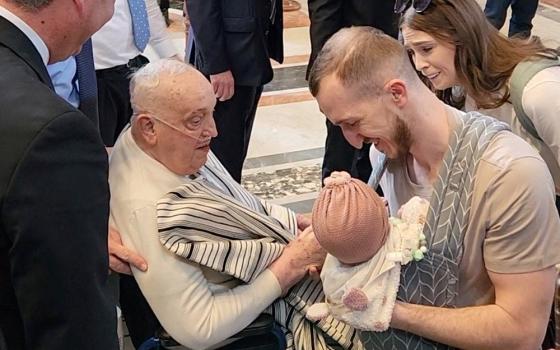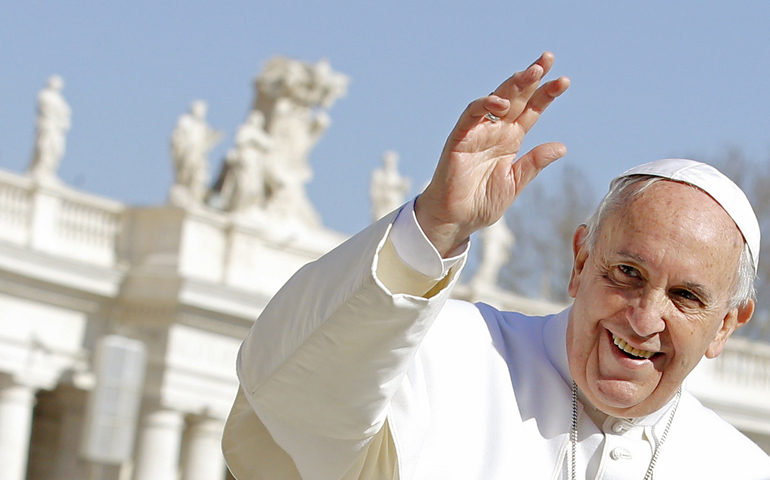
Pope Francis waves as he leads the weekly audience in St. Peter's Square at the Vatican on Feb. 18, 2015. (CNS/Reuters/Giampiero Sposito)
Pope Francis, history's first pontiff from the Global South, has died at age 88 following a months-long respiratory illness, setting the stage for a high-stakes secretive election to determine his successor.
"The Bishop of Rome, Francis, has returned to the house of the Father," announced Cardinal Kevin Farrell from the chapel of the Vatican guesthouse where Francis resided. "His entire life has been dedicated to the service of the Lord and His Church."
"He taught us to live the values of the Gospel with fidelity, courage and universal love, especially in favor of the poorest and most marginalized. With immense gratitude for his example as a true disciple of the Lord Jesus, we commend the soul of Pope Francis to the infinite merciful love of the One and Triune God," said Farrell.
Francis first entered Rome's Gemelli hospital on Feb. 14 after several weeks of struggling to deliver speeches and experiencing shortness of breath. During this fourth — and longest — hospitalization of his papacy — the pontiff's doctors warned that Francis was a "fragile" patient with a history of chronic bronchitis and pulmonary issues that made his illness difficult to treat.
He was discharged on March 23 after a five-week stay where he twice nearly lost his life. Despite a doctor-mandated convalescence of two months, the pope made a number of surprise public appearances, including at the Vatican's Easter liturgy on April 20. Although Francis did not participate in the Easter Mass, he gave the traditional Easter blessing from the loggia of St. Peter's Basilica and made a tour of St. Peter's Square in his popemobile.
The death of the trailblazing pope now leaves the Catholic Church at a crossroads. As members of the College of Cardinals — the elite body of churchmen responsible for electing the next pope — prepare to head into conclave, they will have to decide how the 2,000-year-old institution operates in the modern world.
Francis' death brings to a halt a period of rapid change in the Vatican, where women ascended into new ranks within the hierarchy, where concern for migrants and climate change superseded issues of gender and sexuality and where the church engaged all of its members.
Read more: POPE FRANCIS, PASTOR-PONTIFF, REVITALIZED GLOBAL CATHOLIC CHURCH
But despite the breakneck speed of reform under Francis, he leaves behind an incomplete record. Although he enacted major new legislation on clergy sexual abuse, victims still lament the lack of transparency and accountability in how church law is implemented. And for all his efforts to make the Catholic Church more welcoming to women and LGBTQ Catholics, church reform leaders lament that there remain many impediments for their full inclusion.
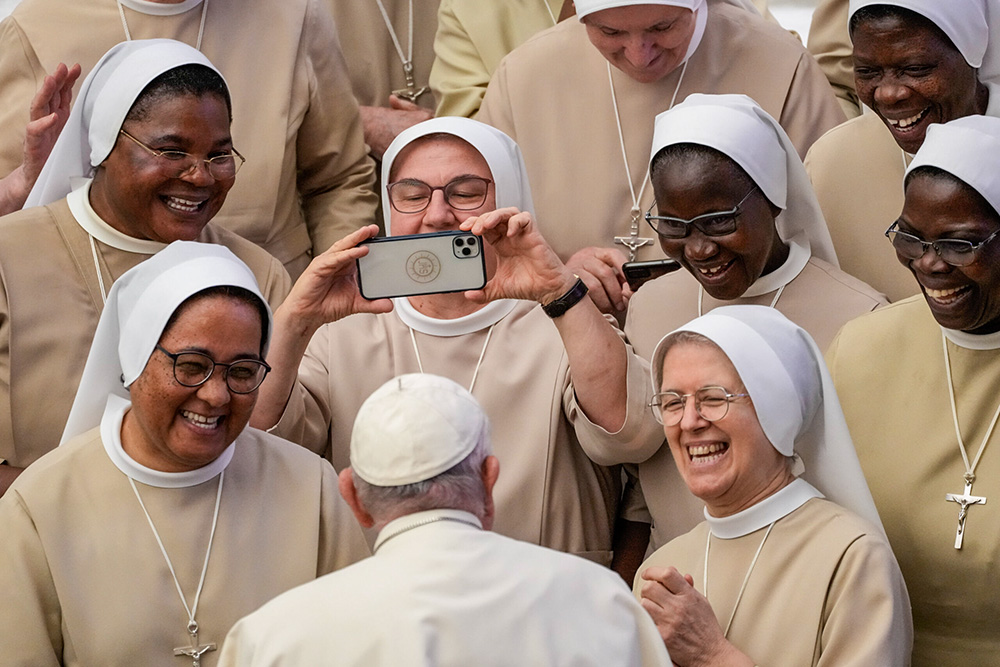
Pope Francis meets a group of nuns during his weekly general audience in the Pope Paul VI Hall at the Vatican, on Aug. 30, 2023. (AP/Andrew Medichini, File)
At the same time, Francis' conservative detractors — who view his changes as out of sync with the church's longstanding tradition — will advocate to seize this moment to seek a course correction.
All of this heightens the stakes for a conclave that will serve as a referendum on Francis' legacy and a moment of reckoning for the unfinished business he left behind — all while trying to preserve some form of unity in a global church of over 1.3 billion Catholics.
While Francis left an indelible stamp on the College of Cardinals, appointing two-thirds of the men who will select his successor, there's no guarantee that they will gather in the conclave to choose a candidate in the mold of Francis.
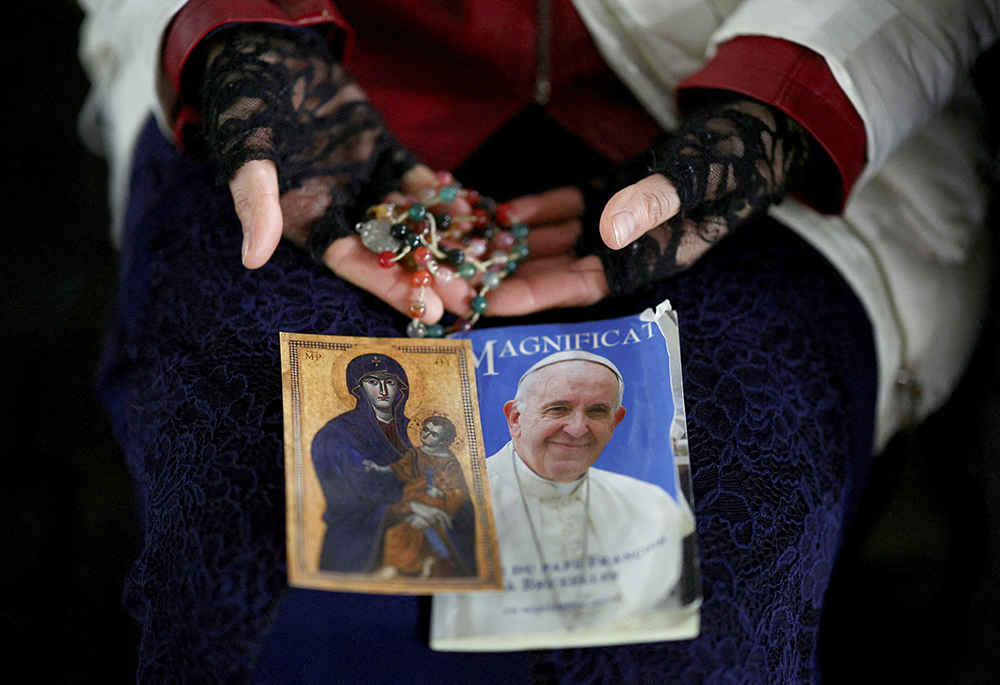
A person holds a rosary, an image of Mary and the Christ Child, and an image of Pope Francis as people join Cardinal Pietro Parolin, Vatican secretary of state, in reciting the rosary for Pope Francis in St. Peter's Square at the Vatican on Feb. 24. (OSV News/Guglielmo Mangiapane)
Over the course of his pontificate, Francis greatly diversified the ranks of the college, giving the cardinal's red hat to clergy from nearly 30 countries that had previously never before been represented in the select group.
When the cardinal-electors assemble at the Vatican in the coming weeks, representing 70 countries around the world, many of the men will be getting to know each other for the first time. Predicting the papal successor will be a challenge because there are no political parties in the Catholic Church indicating the exact theological orientations and pastoral priorities of the cardinals, particularly those lacking major public profiles.
There is no clear favorite heading into the conclave. Yet there are frontrunners who are certainly to be discussed, including:
- Italian Cardinal Pietro Parolin, 70, who served as Francis' longtime secretary of state;
- Italian Cardinal Pierbattista Pizzaballa, 59, a Fransican friar, who is the Latin patriarch of Jerusalem;
- Hungarian Cardinal Péter Erdő, 72, the archbishop of Esztergom-Budapest and a leading favorite among conservatives;
- Filipino Cardinal Luis Tagle, 67, head of the Vatican's evangelization office;
- Canadian Cardinal Gérald Cyprien Lacroix, 67, archbishop of Quebec who served as a member of Francis' Council of Cardinal Advisers;
- American Cardinal Robert Prevost, 69, head of the Vatican office for advising the pope on the appointment of bishops;
- Maltese Cardinal Mario Grech, 68, head of the Vatican's synod office.
But as the proverbial wisdom here in Italy warns: "He who enters the conclave as pope, leaves it as a cardinal."
A statue of St. John Paul II outside of Gemelli hospital where Francis was treated (CNS photo/Justin McLellan)
During his hospital treatment in recent months, the pope received treatment from a medical team of seven specialists on the 10th floor of the private Roman hospital that has long been associated with popes. Over the course of his nearly three-decade papacy, Pope John Paul II was treated there on nearly 10 occasions.
Per Francis' wishes, his funeral is to be held in St. Peter's Square.
It will mark the first funeral for a reigning pope in two decades. The funeral for Pope John Paul II in 2005 drew about four million mourners here to Rome. The last papal funeral — that of retired Pope Benedict XVI — took place in January 2023 and marked a rare occasion of a sitting pope, Francis, presiding over the funeral Mass of his predecessor.
Advertisement
His funeral Mass is expected to be attended by scores of heads of state, alongside church leaders and faithful from all over the globe.
Francis will then be buried at his beloved Roman Basilica of Santa Maria Maggiore — the first pope to be interred outside the Vatican in more than a century and a fitting resting place for a man who prized himself on his independence.
Francis first revealed in a December 2023 interview that he intended to be buried at Santa Maria Maggiore, noting that he wanted to be close to his favorite icon of the Madonna and at a place he would go to pray before and after his international travels.
The day after his election as the 265th successor to St. Peter on March 13, 2013, Francis went to Santa Maria Maggiore to pray.
After his burial there, the 135 cardinals from around the world tasked with electing his successor will begin closed-door meetings to discuss the future of the church and the profile of the man they would like to next lead them.
The National Catholic Reporter's Rome Bureau is made possible in part by the generosity of Joan and Bob McGrath.
